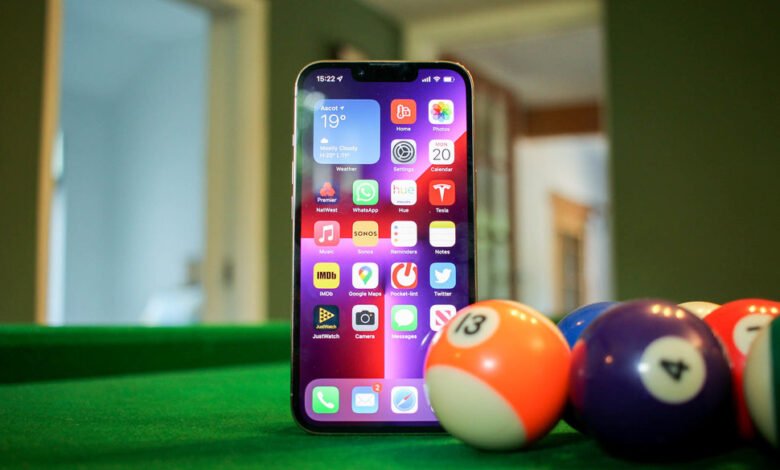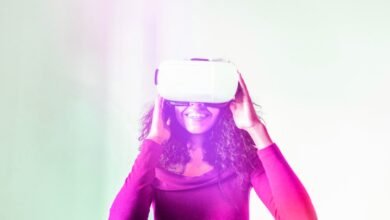iPhone 13 Pro and 13 Pro Max expert review

The iPhone 13 Pro and iPhone 13 Pro Max are Apple’s third consecutive year of releasing two Pro variants. The phones are priced similarly to last year’s 12 Pro and 12 Pro Max, but have upgraded cameras, a larger battery, and an A15 Bionic processor. Apple further clarified the distinction between its Pro and non-Pro phones by cramming the 13 Pro and 13 Pro Max with features that many of us have desired for years, like a display with a high refresh rate. By comparison, three years ago, the label “Pro” appeared to be more of a marketing ploy than a signal that the phone was any more professional than a standard iPhone.
The 13 Pro sends a strong message that there is no one-size-fits-all iPhone. Unlike last year, both phones now feature the identical camera array and are only differentiated by their size, battery life, and pricing.
The iPhone 13 Pro starts at $999 (£949, AU$1,699) for 128GB of storage, while the 13 Pro Max starts at $1,099 (£1,049, AU$1,849). For the first time, you can purchase an iPhone with 1TB of storage. The additional storage costs $1,499 (£1,449, AU$2,569) for the 13 Pro and $1,599 (£1,549, AU$2,719) for the 13 Pro Max. That is a substantial amount of storage… and a substantial amount of money.
Related: iPhone 13: Release date, price and other rumors
The iPhone 13 Pro gets beefier
The phones feature the same angular design as the 12 series. The stainless steel sides are mirror polished, while the rear is matte finished in one of four colors: graphite, gold, silver, or Sierra blue. In some lighting conditions, the Sierra blue iPhone seems to be light gray, but in others, it resembles the Carolina blue of the UNC Tarheels.
The notch has been shrunk by 20%. Although it is not as wide, there is still a notch. It’s reasonable to claim that it bothers me by 20%.
Both phones are larger and heavier. The 13 Pro gains 15 grams, while the 13 Pro Max gains 12 grams. When I used the 13 Pro, I was more aware of the added weight. Both phones feature Apple’s Ceramic Shield on the front and are dust and water resistant to IP68 standards.
ProMotion on the iPhone 13 Pro is stellar
The 13 Pro features a 6.1-inch display, while the 13 Pro Max features a 6.7-inch display. The screens are substantially brighter in normal use. The displays include Apple’s ProMotion technology, which enables the iPhone to sustain a high refresh rate for the first time ever. The refresh rate varies between 10 and 120Hz depending on what is displayed on the screen. This is a similar technique to the one taken by Samsung with the Galaxy S21 Ultra. When in usage, the screen is stunning. Smooth animations, clean images, and even basic items like scrolling feeds appear better.
Telephoto Camera in iPhone 13 Pro
The primary camera features a new sensor that is the biggest ever integrated into an iPhone. It features a lens with a faster f1.5 aperture, which results in increased light collecting. The ultrawide features a new autofocus sensor and lens that enhances light gathering capabilities. Finally, the telephoto camera receives a new sensor and lens with a 3x optical zoom extension.
While using the Pro iPhones resulted in brighter photos, the difference was not always apparent. Additionally, I found that images had rapid shutter speeds, which resulted in better freezing of activity, such as when I captured individuals riding bikes.
Additionally, capturing a photo in Night mode was faster and compatible with the 3x telephoto camera. The iPhone 11 and 12 series cameras have an odd property where they reflected light sources. On the 13 Pro and 13 Pro Max, the peculiarity persists, especially if your shot includes string lights, but it is significantly improved.
The iPhone 13 Pro cameras bring you even closer to your subject
The 13 Pro and 13 Pro Max include a new macro mode that activates automatically as you approach your subject within a few millimeters. To put the cameras and Macro capability to the test, I went the iPhone 13 Pro Max and iPhone 13 to the Feast of the Field, a component of Greenville, South Carolina’s annual Euphoria food festival. This resulted in a delectable camera test.
Macro photography works by automatically switching from wide to ultrawide mode as you move closer to your subject. With autofocus, the ultrawide can now focus on objects as close as a few of centimeters distant.
I found macro photography on the iPhone to be rather effective in bright and moderate lighting. While it is not on the same level as a mirrorless camera with a dedicated macro lens, it is one of the better implementations of a macro mode on a phone that I have seen. I got excellent close-up photographs of food and coffee, and even captured a terrifying video footage of ants crawling all over an abandoned grapefruit.
At the event’s main dinner, I discovered two things: To begin, gooseberries are delectable. And then there’s the fact that the iPhone still uses the ultrawide camera to shoot macro photos in low light. The phone’s best camera is the wide-angle lens, which also performs admirably in low-light circumstances. Additionally, because the phone must be so close to the subject, it covers some of the light, resulting in mediocre close-ups. At the moment, there is no method to disable macro capability. Apple said that a new setting will be enabled in a fall software update that would allow you to disable automatic camera switching when taking macro photography or video at close distances.
I’m all about Cinematic mode on the iPhone 13 Pro
All iPhone 13 models now include a new function called Cinematic mode. It creates a 1080p video at 30 frames per second using the back cameras or the True Depth camera array. What makes the video compelling is that everything else is out of focus except your subject. Additionally, the iPhone can do a rack focus from one subject to another. The result is striking and awe-inspiring.
The tool, similar to Portrait mode for images, allows you to adjust the depth of field. What’s fantastic is that the phone can perform all functions, including selecting who is in focus and when to alter it. You can tap and manually adjust the focus points and aperture during the recording. Alternatively, you can accomplish all of this after the fact.
Are cinematic videos infallible? No, but it’s a lot of fun to play with and experiment with. Cinematic mode performs best when there is sufficient light. If the lighting is too dim, you’ll receive a pop-up instructing you to turn on your flash.
Additionally, I discovered that Cinematic mode struggled to maintain focus on fast-moving nonhuman subjects, such as water being poured from a spout or a shot of espresso being prepared. Additionally, when editing a film in Cinematic mode, the controls for the focus keyframes are quite small. You can long-press to expand them, but once you let go, they revert to their original size.
Expect Cinematic mode to be your default setting if you want dependably good-looking videos. While this is a fun tool, standard video looks superior in the vast majority of circumstances.
Not all A15 Bionic power is the same
Apple’s new A15 Bionic chip powers everything. On the Pro versions, the GPU has five cores, compared to four on the 13 and 13 Mini. During my time testing the phones, they had no issue handling gaming, photo editing, or having a slew of apps open simultaneously.
The iPhone 13 Pro Max has the longest battery life of any phone we tested
The battery on both the 13 Pro and 13 Pro Max is larger. I had no difficulty going through a day, even a hot and humid one during which I took a lot of images and films. The iPhone 13 Pro easily lasts a day on a single charge for me, whereas the iPhone 13 Pro Max can last up to two days on a single charge. Both phones feature a longer battery life than the iPhone 12 Pro and 12 Pro Max from last year.
The larger battery is not the only factor that contributes to improved battery performance. A significant portion of the improvement is due to the LTPO display’s automated refresh rate adjustment. The iPhone 12 Pro and 12 Pro Max feature a fixed refresh rate of 60Hz, however the iPhone 13 Pro and 13 Pro Max can reduce the refresh rate to as low as 10Hz while conserving power.
I’ve owned all four iPhone 13 versions for approximately five days, and there are still several aspects I need to explore more thoroughly before I can give you an accurate review. Let us conclude by discussing a few of the remaining questions.
- iOS 15 is fantastic on the 13 Pro and 13 Pro Max. It offers a slew of features while maintaining the status quo. I adore the Focus mode.
- All iPhone 13 models now include a new feature called Photographic styles, which allows you to switch between normal, the usual iPhone look, and four additional styles: Vibrant, Rich Contrast, Warm, and Cool. Apple asserts that these are more than filters. Your phone evaluates the many parts of your subject to create the desired effect without, for example, unduly orangenating someone’s complexion. Apple performs all of this while the photo is being taken, and it is baked into the file.
- These are the first phones to support Apple’s ProRes video encoding standard. ProRes optimizes video files and is especially beneficial for those who color grade or edit with Final Cut Pro X or Adobe Premiere Pro. ProRes video files are less compressed yet take up a lot of space, which is why the 1TB storage tier is critical. Regrettably, ProRes is not now available for testing and will be released later this year.
I still have additional in-depth testing to complete on the iPhone 13 Pro and 13 Pro Max, and our team will conduct its customary barrage of camera, drop, and battery tests. Continue to check back for updates as we discover more about these phones.
IPHONE 13 SPECS VS. 13 MINI, 13 PRO, 13 PRO MAX
| iPhone 13 Mini | iPhone 13 | iPhone 13 Pro | iPhone 13 Pro Max | |
|---|---|---|---|---|
| Display size, resolution | 5.4-inch OLED; 2,340×1,080 pixels | 6.1-inch OLED; 2,532×1,170 pixels | 6.1-inch OLED; 2,532×1,170 pixels | 6.7-inch OLED; 2,778×1,284 pixels |
| Dimensions (Inches) | 5.18×2.53×0.3 in | 5.78×2.82×0.3 in | 5.78×2.82×0.3 in | 6.33×3.07×0.3 in |
| Dimensions (Millimeters) | 132x64x7.65 mm | 147x72x7.65 mm | 147x72x7.65 mm | 161x78x7.65 mm |
| Weight (Ounces, Grams) | 4.97 oz; 141g | 6.14 oz; 174g | 7.19 oz; 204g | 8.48 oz; 240g |
| Mobile software | iOS 15 | iOS 15 | iOS 15 | iOS 15 |
| Camera | 12-megapixel (wide), 12-megapixel (ultrawide) | 12-megapixel (wide), 12-megapixel (ultrawide) | 12-megapixel (wide), 12-megapixel (ultrawide), 12-megapixel (telephoto) | 12-megapixel (wide), 12-megapixel (ultrawide), 12-megapixel (telephoto) |
| Front-facing camera | 12-megapixel | 12-megapixel | 12-megapixel | 12-megapixel |
| Video capture | HDR video recording with Dolby Vision up to 4K at 60 fps | HDR video recording with Dolby Vision up to 4K at 60 fps | ProRes video recording up to 4K at 30 fps (1080p at 30 fps for 128GB storage)* | ProRes video recording up to 4K at 30 fps (1080p at 30 fps for 128GB storage)* |
| Processor | Apple A15 Bionic | Apple A15 Bionic | Apple A15 Bionic | Apple A15 Bionic |
| Storage | 128GB, 256GB, 512GB | 128GB, 256GB, 512GB | 128GB, 256GB, 512GB, 1TB | 128GB, 256GB, 512GB, 1TB |
| Expandable storage | No | No | No | No |
| Battery | Undisclosed; Apple lists 17 hours of video playback | Undisclosed; Apple lists 19 hours of video playback | Undisclosed; Apple lists 22 hours of video playback | Undisclosed; Apple lists 28 hours of video playback |
| Fingerprint sensor | No (Face ID) | No (Face ID) | No (Face ID) | No (Face ID) |
| Connector | Lightning | Lightning | Lightning | Lightning |
| Headphone jack | No | No | No | No |
| Special features | 5G enabled; MagSafe; water resistant (IP68); wireless charging; dual-SIM capabilities (nano-SIM and e-SIM) | 5G enabled; MagSafe; water resistant (IP68); wireless charging; dual-SIM capabilities (nano-SIM and e-SIM) | ProMotion technology with adaptive refresh rates up to 120Hz; lidar scanner; 5G enabled; MagSafe; water resistant (IP68); wireless charging; dual-SIM capabilities (nano-SIM and e-SIM) | ProMotion technology with adaptive refresh rates up to 120Hz; lidar scanner; 5G enabled; MagSafe; water resistant (IP68); wireless charging; dual-SIM capabilities (nano-SIM and e-SIM) |
| Price off-contract (USD) | $699 (128GB), $799 (256GB), $999 (512GB) | $799 (128GB), $899 (256GB), $1,099 (512GB) | $999 (128GB), $1,099 (256GB), $1,299 (512GB), $1,499 (1TB) | $1,099 (128GB), $1,199 (256GB), $1,399 (512GB), $1,599 (1TB) |
| Price (GBP) | £679 (128GB), £779 (256GB), £979 (512GB) | £779 (128GB), £879 (256GB), £1,079 (512GB) | £949 (128GB), £1,049 (256GB), £1,249 (512GB), £1,449 (1TB) | £1,049 (128GB), £1,149 (256GB), £1,349 (512GB), £1,549 (1TB) |
| Price (AUD) | AU$1,199 (128GB), AU$1,369 (256GB), AU$1,719 (512GB) | AU$1,349 (128GB), AU$1,519 (256GB), AU$1,869 (512GB) | AU$1,699 (128GB), AU$1,869 (256GB), AU$2,219 (512GB), AU$2,569 (1TB) | AU$1,849 (128GB), AU$2,019 (256GB), AU$2,369 (512GB), AU$2,719 (1TB) |












3 Comments